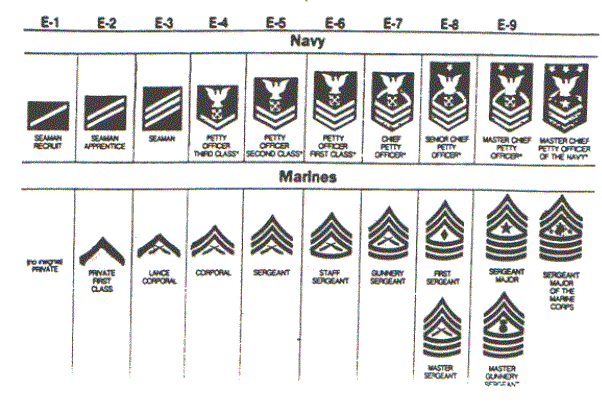
Starting pay $2,849/mo - max $4,413/mo with over 18 years' experience Starting pay $2,610/mo - max $3,704/mo with over 12 years' experience Starting pay $2,393/mo - max $2,906/mo with over 10 years' experience Starting pay $2,161/mo - max $2,436/mo with over 10 years' experience These base pay scales were in force from Jto June 31, 1946.United States Navy Enlisted Pay (Ordered By Seniority) (This was increased to $31 a month after July 1, 1942). Recruits were paid $21 a month for the first 4 months of service. These base pay scales were in force from Jto June 30,1946. Halsey's promotion, like that of General Omar Bradley, was as a reward for his service and accomplishments rather than a wartime command authority. However, he would have seniority in Navy matters due to military courtesy two officers of equivalent rank in different services would defer to their sphere of influence (the Army on the ground and the Navy at sea). This was difficult to manage as MacArthur technically had seniority in grade (having been promoted to General of the Army the day before him on December 18th). Nimitz's promotion was designed to coordinate the overall Pacific Area strategy.

Marshall and Admiral King respectively) and acted as a combined chief of staff over both of them. Leahy was the link between the President and the Army and Navy service chiefs (General George C. Leahy's and King's promotions were created to facilitate coordination with the US Army and the many allied forces they would be dealing with. They were staggered so the Navy, the "Senior Service", would have precedence over the Army. The promotions were made parallel to the Army's 5-star General of the Army promotions. Seniority between the rank's holders was by the date it was granted. It was the first American honorary military rank to be given to multiple holders simultaneously. Only four men were awarded the rank of Fleet Admiral. It was a command rank equivalent to that of Admiral of the Fleet in European navies that was created alongside General of the Army to create a similar rank and prestige for the Navy. The five-star Fleet Admiral rank was approved on Decemunder Public Law 78-482 as a temporary rank and was made permanent in 1946. In the British Navy the Admiral commanded the center of a formation and coordinated the actions of his subordinates. The title Admiral is derived from the Arabic title Emir ( amīr-al-'umarā, "ruler of rulers"). He and and his flagship coordinated the ships at the front (or "Van") of a formation and passed on gathered information to and signals and orders from the commanding Admiral. In the British Royal Navy, the Vice Admiral was an assistant to the Admiral. However, the rank of Rear Admiral was a two-star rank with 8th Pay Period salary regardless of Division.

Rear Admiral Lower Half, the junior division, was roughly equivalent to a Brigadier General, and Rear Admiral Upper Half, the senior division, was roughly equivalent to Major General.

The rank in American service was divided into two Divisions by seniority in grade. In the British Royal Navy, the Rear Admiral and his flagship coordinated the ships at the back of a formation and passed on signals and orders from the commanding Admiral. The last World War II holder of the rank was Commodore Tully Shelley, who retired in July, 1949 with the rank of Rear Admiral. No further appointments were made after 1947 but holders were allowed to remain in the rank until they were promoted or retired. It generally denoted an officer who commands a detachment of ships or aircraft, but is not yet senior enough to rank as an Admiral. Captains who had held the post often styled themselves as such unofficially afterwards.ĭue to the rapid expansion of the Navy the rank was re-established on April 1943. In American service the position was originally a brevet rank held by the senior-most captain in a formation of two or more ships. "Commodore" is better considered a title or appointment than a proper rank. The Flag Officer ranks were based on those of the British Royal Navy.


 0 kommentar(er)
0 kommentar(er)
